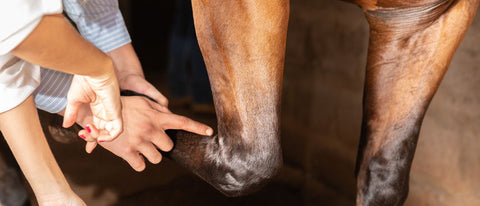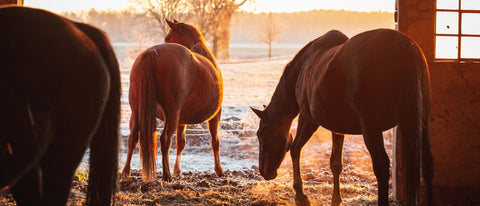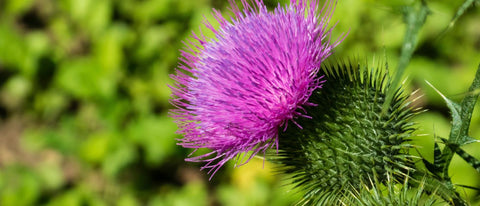
Florian ist aufgewachsen auf einem Bauernhof. Umgeben von Pferden, entdeckte er früh seine Faszination für diese majestätischen Tiere. Inspiriert von seiner reitbegeisterten Mutter, entwickelte er das Nahrungsergänzungmittel - Pferdegold. Seine tiefe Verbundenheit zur Natur und die leidenschaftliche Hingabe zu Pferden trieben ihn an, sein Unternehmen zu gründen.
If your horse is lame, it could be spavin, a disease of the hock joint. Your horse should be examined regularly by a veterinarian.
The disease usually progresses in phases, so your pet isn't in constant pain. This article will show you what treatment options are available and what you can do yourself.

What is spavin in horses?
What is spavin in horses? Spavin is a horse disease that can affect one or both hind legs and is associated with wear and tear of the hock joint .
Spavin in horses usually occurs in bouts and is one of the most common joint diseases in riding horses . When spavin occurs in horses, they do not suffer from constant pain.
With appropriate treatment and care, your pet will usually have a good quality of life despite the illness.
Spavin can occur in any horse. However, this incurable disease is particularly common in older horses, eight years and older.
Inflammatory changes often occur here, which can lead to bone growths. This can subsequently lead to joint deformities. If the disease is left untreated, the joint's movement can be severely restricted.
All causes at a glance
Spavin can have different causes, which are not always entirely clear.
It is not known whether the disease is hereditary.
However, a predisposition such as a leg structure that favors spavin can be inherited.
These are the most common causes :
- Overload , especially in younger horses
- mechanical impacts such as kicks, strains or sprains
- growth-related disorders
- incorrect feeding and mineral deficiencies
- Joint misalignments
- Lack of exercise
- inadequate and incorrect hoof care by the farrier
- Inflammation of the ankle
In young horses, spavin is usually caused by a specific event such as a fall or severe twisting of the joint.
Typical symptoms: How can the disease manifest itself?
If you notice your horse limping , it could be a sign of spavin. Lameness is one of the earliest symptoms and most often occurs after a period of rest when the horse begins to move again.
The lameness is usually due to pain in the hock area . The symptoms improve when the horse moves, but recur after long periods of exertion.
If your horse has spavin, its gait will be noticeable during a flare-up.
The horse shuffles its affected hind leg and drags its hoof along the ground. If it is in severe pain, it will try to relieve the weight on the affected leg. Over time, bone thickening may occur in the joint .
During an acute attack, the small joints, bones, and periosteum are inflamed. The affected ankle is swollen and warm .
Sometimes the tendon on the inside of the hock is also inflamed . Prolonged inflammation can lead to osteoarthritis in the horse.
The gait changes more and more as the disease progresses:
- swingless and shortened trot
- shorter steps than usual
- frequent stumbling
- Difficulty changing tempo
During a flare-up, the horse assumes a protective posture due to the pain, which can lead to stiffness in the joint and a decrease in the muscles of the back and croup.
The back muscles may be tense . Spavin may also present with a tilted pelvis.

Pferdegold® supplementary feed!
Pferdegold is a small family business from Bavaria with a big dream: to produce the best horse feed. We see ourselves as a family of equestrians who want to provide your horse with the ideal nutrition. 100% natural and perfectly tailored to your horse's needs.
Try it now!How is spavin diagnosed?
Spavin is most easily diagnosed during an acute flare-up of inflammation , when your horse is already significantly lame and is resting the affected leg. The veterinarian will examine your horse at rest and in motion. They will perform a flexion test, lifting the affected hind leg and flexing it as far as possible . The horse may then show significant lameness, which may improve after a few steps.
X-rays provide a more accurate diagnosis of spavin in horses. These can reveal changes in the bone . As the disease progresses, exostoses, which are bone growths, may also be visible on X-rays. The veterinarian can also administer local anesthesia to the hock and perform a flexion test.
The suspicion of spavin is confirmed if your horse does not limp when walking.
Spavin in horses: What helps? Treatment & therapy
When spavin occurs in horses, there is no treatment that can completely cure your animal . Instead, it is important to delay the joint changes for a long time .
Treatment should begin as early as possible.
During the acute phase, the veterinarian will prescribe anti-inflammatory and pain-relieving medications . The veterinarian may also inject medications directly into the affected joint.
To relieve pressure on the affected areas of the hock, a farrier can perform orthopedic forging . The horse will receive special orthopedic shoes.
If the disease is already advanced, surgery to accelerate ossification of the joint can help. Your horse will then be able to walk pain-free again.
If your horse requires surgery for spavin, the costs depend on the surgical method and the extent of the procedure.

Can spavin be prevented in horses?
Prevention of spavin should begin as early as foalhood by counteracting nutritional deficiencies. In the further course of the disease, appropriate exercise and training are important, in addition to appropriate feeding.
- Feeding with a good nutrient balance
- regular and correct hoof care
- Regeneration through regular rest breaks
- Training with appropriate warm-up phase and adapted to the level of performance
- lots of exercise
- Avoid tight turns and hard surfaces
-
no traversals , high jumps or strenuous work
Can you still ride a horse with spavin? This is what you need to consider when training horses with spavin!
Only in severe cases is it impossible to ride a horse with spavin. You can ride horses with spavin, provided there is no acute attack .
The horse should be exercised regularly, tailored to its health condition, to prevent the condition from worsening. You and your veterinarian will discuss what's possible.
Conclusion
Spavin is a disease of the hock joint that cannot be cured. Your horse won't experience constant discomfort, as the disease occurs in phases. During a phase, the horse will limp and exhibit an altered gait. It will be in pain and adopt a protective posture.
A veterinarian can diagnose spavin with an X-ray. Treatment can be done with medication. In severe cases, surgery is necessary. You can prevent spavin with targeted training.
IMPORTANT:
Pferdegold is not a substitute for veterinary diagnosis or treatment . The information contained in this article is for general informational purposes only and is intended to help improve your horse's well-being.
Pferdegold products do not treat or cure diseases , but rather support your horse in correcting nutritional deficiencies through targeted nutrient intake. However, they are not a substitute for professional advice from a veterinarian or specialist.
If your horse has any health problems, we strongly recommend consulting a veterinarian . Pferdegold assumes no liability for decisions made based on the information provided here.
FAQ
How serious is spavin in horses?
Spavin can be painful for horses and is incurable . However, your horse won't be in constant pain, as the disease occurs in phases. Joint wear and tear progresses over time.
Should you shoe a horse with spavin?
A horse with spavin can receive special orthopedic shoes from the farrier to relieve pressure on the affected joint.
Is spavin curable in horses?
Spavin is incurable. With proper treatment, its progression can be slowed .
🐎 Want to learn more about horse health? Read on now!

















